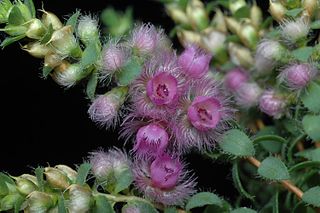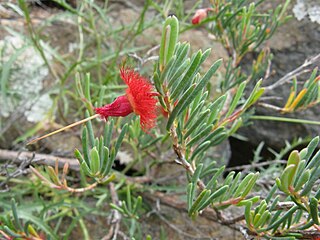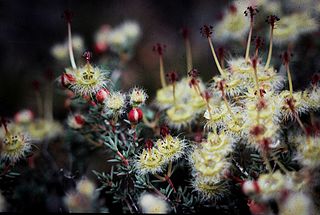
Verticordia eriocephala, commonly known as lambswool, and common, native or wild cauliflower is a flowering plant in the myrtle family, Myrtaceae and is endemic to the south-west of Western Australia. It is a shrub with one densely branching, spreading main stem, small leaves and dense heads of creamy-white flowers, giving rise to the common names "lambswool" and "cauliflower". It is widespread over its range but becoming less common because of land clearing and illegal collecting of the flowers.

Verticordia blepharophylla is a flowering plant in the myrtle family, Myrtaceae and is endemic to the south-west of Western Australia. It is an erect, open shrub with a single main stem, leaves with hairy margins and pale to deep mauve-pink flowers and which occurs in an area between Perth and Geraldton.

Verticordia halophila, commonly known as salt-loving featherflower, or salt-loving verticordia, is a flowering plant in the myrtle family, Myrtaceae and is endemic to the south-west of Western Australia. It is an erect, bushy shrub with small, crowded, thick leaves and spikes of red and pink flowers in spring.
Verticordia harveyi, commonly known as autumn featherflower, is a flowering plant in the myrtle family, Myrtaceae and is endemic to the south-west of Western Australia. It is a slender, spindly shrub with relatively long leaves and small white, pink or magenta-coloured flowers in late summer and autumn.

Verticordia helichrysantha, commonly known as coast featherflower or Barrens featherflower, is a flowering plant in the myrtle family, Myrtaceae and is endemic to the south-west of Western Australia. It is a small, woody, open-branched shrub with crowded, linear leaves and small yellow flowers from May to September.
Verticordia verticordina is a flowering plant in the myrtle family, Myrtaceae and is endemic to a small area near the coast of the south-west of Western Australia. It is a small, low-growing shrub with crowded leaves and in spring, scattered pale greenish-cream and golden brown flowers. Its unusual flowers and fleshy leaves give the plant a superficial resemblance to a Darwinia.
Verticordia centipeda is a flowering plant in the myrtle family, Myrtaceae and is endemic to the south-west of Western Australia. It is a shrub with a single stem at the base, small crowded leaves and greenish-pink flowers with a silvery fringe, in spike-like groups on the ends of the branches. It is common in areas around Geraldton.

Verticordia humilis, commonly known as small featherflower, is a flowering plant in the myrtle family, Myrtaceae and is endemic to the south-west of Western Australia. It is a small shrub with leafy branches and scattered, mostly red flowers hanging loosely near the ends of the branches.

Verticordia inclusa is a flowering plant in the myrtle family, Myrtaceae and is endemic to the south-west of Western Australia. It is a small shrub with small, thick leaves and groups of scented, mostly white to pale pink flowers with a red centre on the ends of the branches in spring.
Verticordia integra, commonly known as plastic verticordia, is a flowering plant in the myrtle family, Myrtaceae and is endemic to the south-west of Western Australia. It is a shrub with only a few branches, with very thick oblong to egg-shaped leaves and heads of shiny golden-coloured flowers in late spring.
Verticordia mirabilis is a flowering plant in the myrtle family, Myrtaceae and is endemic to a small area in the Gibson Desert. It is a bushy, spreading shrub with its leaves mostly crowded on short side branches and with large, deep red flowers in small groups in spring.

Verticordia mitchelliana, commonly known as rapier featherflower, is a flowering plant in the myrtle family, Myrtaceae and is endemic to the south-west of Western Australia. It is a shrub with bright red, rapier-like flowers in spring and early summer, which readily distinguish it from other species. It is commonly grown in private gardens and some forms have larger flowers than those usually found in the wild.

Verticordia oxylepis, commonly known as bonsai featherflower, is a flowering plant in the myrtle family, Myrtaceae and is endemic to the south-west of Western Australia. It is a small shrub, often with a layered appearance, small leaves and very small yellow and pink flowers.
Verticordia paludosa is a flowering plant in the myrtle family, Myrtaceae and is endemic to the south-west of Western Australia. It is an openly branched shrub with small leaves and pink to magenta flowers with spreading, feathery sepals and erect, fringed petals in summer and autumn.

Verticordia penicillaris is a flowering plant in the myrtle family, Myrtaceae and is endemic to the south-west of Western Australia. It is a small, widely spreading shrub, usually with several main branches. It is readily distinguished from other verticordias by its yellow flowers with white fringes and purple hairs on the end of their long styles.
Verticordia polytricha, commonly known as northern cauliflower, is a flowering plant in the myrtle family, Myrtaceae and is endemic to the south-west of Western Australia. It is an erect, bushy shrub with linear leaves and dense heads of white flowers in late spring and summer.
Verticordia pulchella is a flowering plant in the myrtle family, Myrtaceae and is endemic to the south-west of Western Australia. It is a much-branched shrub with short, narrow leaves and feathery red or red and yellow flowers with long styles in spring and early summer.
Verticordia setacea is a flowering plant in the myrtle family, Myrtaceae and is endemic to the south-west of Western Australia. It is a shrub with small leaves and deep pink flowers with short styles in late spring.
Verticordia wonganensis is a flowering plant in the myrtle family, Myrtaceae and is endemic to the south-west of Western Australia. It is a shrub which grows near Wongan Hills and has a single main stem, small leaves and spike-like groups of large, pink, feathery flowers.
Verticordia × eurardyensis, commonly known as Eurardy magenta, is a flowering plant in the myrtle family, Myrtaceae and is endemic to a small area in the south-west of Western Australia. It is a shrub similar to both Verticordia dichroma and Verticordia spicata which grow in the same area and is thought to be a stable hybrid between those two species. It has mostly egg-shaped leaves and spike-like groups of dark magenta-coloured flowers which fade to straw-coloured, in late spring and early summer.










